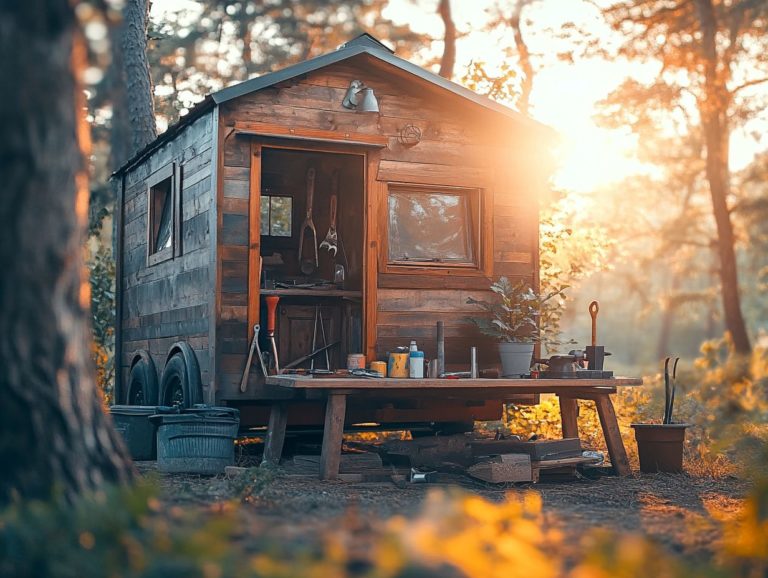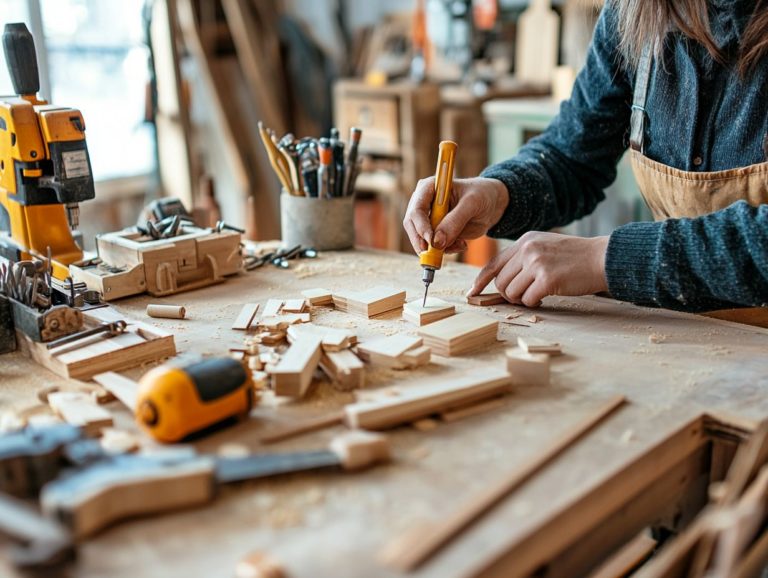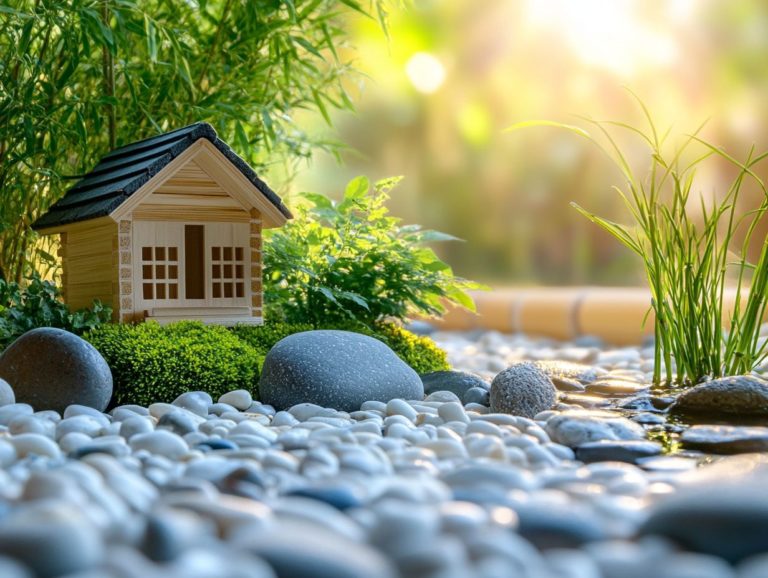How to Build a Tiny House Murphy Bed
If you reside in a tiny house, maximizing your space becomes essential. A Murphy bed presents an ideal solution, seamlessly transforming limited square footage into a multifunctional living area.
This article delves into the benefits of Murphy beds, guiding you through the design and building process specifically tailored for tiny homes. You ll find key considerations to ponder, along with a step-by-step guide, recommended materials, and valuable tips for customization and maintenance.
Uncover how to craft a stylish and practical sleeping solution that perfectly aligns with your lifestyle!
Contents
- Key Takeaways:
- Benefits of a Murphy Bed in a Tiny House
- Designing and Building a Murphy Bed for a Tiny House
- Materials and Tools Needed
- Tips for Customizing and Personalizing Your Murphy Bed
- Maintenance and Care for Your Murphy Bed
- Frequently Asked Questions
- What materials do I need to build a tiny house Murphy bed?
- Do I need any special tools to build a tiny house Murphy bed?
- How much space will a tiny house Murphy bed take up?
- Can I use a regular mattress for a tiny house Murphy bed?
- Will building a tiny house Murphy bed require any special skills?
- Can I customize the design of my tiny house Murphy bed?
Key Takeaways:
- A Murphy bed is a space-saving and versatile option for tiny houses, providing a comfortable sleeping area without taking up valuable floor space.
- When designing and building a Murphy bed for a tiny house, consider factors such as the size and weight of the bed, its placement, and functionality.
- To ensure proper maintenance and care for your Murphy bed, regularly check and clean the mechanisms, and consider adding unique features to personalize your bed.
What is a Murphy Bed?
A Murphy bed, often referred to as a wall bed, is an elegant, space-saving solution that maximizes the functionality of small spaces especially in tiny houses where every square foot is valuable.
Invented by William Lawrence Murphy in the early 20th century, this ingenious design folds up against the wall when not in use, transforming your bedroom into a multi-functional area that can effortlessly serve as a guest room or a cozy studio.
With the tiny house movement gaining momentum, Murphy beds have become critical for optimizing interior design and creating efficient living environments.
Murphy beds enhance spatial efficiency and spark creative design choices. Often adorned with sleek finishes and customizable features, they can harmonize beautifully with a range of aesthetics, from modern minimalism to rustic charm.
Beyond their practicality, they symbolize a broader shift in home architecture that prioritizes sustainability and smart living. As urban spaces grow increasingly compact, this clever solution emerges as a key player in design conversations, championing the principles of minimalism while ensuring comfort and versatility in densely populated areas.
Benefits of a Murphy Bed in a Tiny House
Incorporating a Murphy bed into your tiny house presents a range of benefits that seamlessly align with the tiny living philosophy, promoting efficiency and innovative solutions for constrained spaces.
As you seek to downsize and simplify your lifestyle, the versatility of a Murphy bed transforms your small area into a functional haven that can easily adapt to your diverse needs be it hosting guests or crafting a cozy reading nook.
- Space-saving functionality
- Adaptability for various needs
- Enhanced aesthetic appeal
Space-saving and Versatility
The Murphy bed is the epitome of space-saving design, offering you versatility that s especially advantageous in tiny houses and studio apartments, where making the most of every inch is essential.
In these compact living spaces, a Murphy bed transforms from a functional sleeping area into a chic piece of furniture when folded away. You can take full advantage of the liberated space, creating a cozy reading nook with a small bookshelf and a comfortable chair, or even setting up a mini office with a desk and clever storage solutions.
The wall space surrounding the bed can serve a dual purpose, acting as both an art display and functional shelving, fostering an aesthetic that beautifully merges design with practicality.
This multifunctional approach not only elevates the livability of small spaces but also captures the essence of tiny living, blending comfort with creativity.
Designing and Building a Murphy Bed for a Tiny House
Designing and building a Murphy bed for your tiny house demands meticulous planning and a dash of creativity to ensure it harmonizes effortlessly with your home s architecture and caters to your specific needs.
From choosing the perfect materials to determining the bed s dimensions, this design process plays a crucial role in optimizing interior aesthetics within the constraints of small spaces. It s not just about functionality; it s also a chance to express your personal style and meet your practical requirements seamlessly.
In summary, a Murphy bed not only maximizes your space but also adds a touch of style and versatility to your tiny house. Consider integrating one into your home today and experience the benefits firsthand!
Factors to Consider
When designing a Murphy bed for a tiny house, there are several essential factors to consider for optimal functionality and aesthetics. You need to think about the available space and your preferred design style. Make sure the bed fits well with your home design. This maximizes space and ensures it’s easy to use for everyone.
It s also crucial to consider accessibility and the bed’s size, which must fit standard mattress dimensions while comfortably fitting within the room s layout to maintain a seamless flow. Additionally, ensure the bed has a suitable weight capacity for durability and safety, allowing it to support various users while remaining easy to operate.
Thoughtful placement can significantly enhance the room’s functionality, allowing you to navigate your living space without obstacles, particularly in smaller dwellings. By incorporating creative storage solutions alongside the Murphy bed, you can embrace the art of tiny house living, achieving a harmonious balance between utility and comfort.
Step-by-Step Guide
Ready to transform your tiny space? Creating a Murphy bed can be an incredibly satisfying DIY project for you. Following a clear, step-by-step guide will simplify the process and pave the way for a successful outcome.
This innovative solution maximizes the limited space typical of tiny living while adding a stylish flair to your room, perfectly marrying functionality with aesthetic appeal. If you’re ready to dive into this project, gathering the right materials and tools is essential. You’ll need:
- Plywood
- A sturdy mattress
- Hinges
- A locking mechanism
And don t forget essential tools like a drill, saw, and screwdriver. The assembly process involves carefully measuring and cutting the wood, securing the frame, and installing the bed mechanism, ensuring everything is level for safe operation.
The customization options are endless, allowing you to personalize the finish and design to harmonize with your unique space.
Materials and Tools Needed
When building a Murphy bed for your tiny house, choosing the right materials and tools becomes paramount. Choosing the right materials gives you both durability and style!
Recommended Supplies
To successfully build a Murphy bed in your tiny house, it s essential to gather the necessary supplies for a sturdy and functional design.
Start by selecting high-quality plywood for the bed frame this material offers both strength and a lightweight profile, crucial for space-saving furniture. Don t overlook the importance of using hardwood for the bed s support arms, as they need to endure frequent use while ensuring lasting durability.
Appropriate hardware is also key heavy-duty hinges and a robust locking mechanism will secure the bed safely when it s not in use.
Investing in quality tools, like a power drill and a miter saw, will streamline your construction process, allowing for precise cuts and efficient assembly. Each of these components is instrumental in crafting a compact yet comfortable living space, vital in the world of home design and tiny living.
Tips for Customizing and Personalizing Your Murphy Bed
Customizing and personalizing your Murphy bed can elevate its functionality and aesthetic appeal, transforming it into a distinctive centerpiece in your tiny house that beautifully reflects your personal style and creativity.
Creative Ideas for Unique Features
Exploring creative ideas for unique features in a Murphy bed can elevate a standard design into a functional work of art, enriching your tiny house’s overall aesthetic and utility.
By incorporating innovative elements like built-in storage compartments, you can organize your belongings efficiently without sacrificing precious floor space. Imagine foldable tables that seamlessly attach to the bed, providing a versatile dining or work area that can be tucked away with ease when not in use.
Consider hidden lighting solutions to create an inviting ambiance, making your small space feel larger and more welcoming. With these advancements, your Murphy bed can truly embody the principles of tiny living, blending style and practicality to maximize every inch and achieving a harmonious balance of design and functionality.
Get started on your Murphy bed today and make the most of your tiny home!
Maintenance and Care for Your Murphy Bed
Proper maintenance and care of your Murphy bed are crucial for ensuring its longevity and functionality in the dynamic living environment of your tiny house. Treat this piece of furniture with the attention it deserves to make the most of your space while enjoying the convenience and comfort it offers.
Keeping Your Bed in Good Condition
To maintain your Murphy bed in optimal condition, it’s essential to adopt regular maintenance practices. Focus on both the parts that help it work and the parts that make it look good. This innovative piece of furniture is often praised by HGTV and the DIY Network.
These tasks may include lubricating the hinges to guarantee smooth operation, significantly prolonging the lifespan of the bed’s functional components. It’s also important to check for any signs of wear or damage; early detection can save you from more extensive repairs down the line.
Regularly cleaning the upholstery not only elevates the bed s appearance but also fosters a healthier sleeping environment, aligning with the principles of the Handcrafted Movement. By prioritizing these maintenance practices, you can keep your Murphy bed stylish and functional for years to come, drawing inspiration from Incredible Tiny Homes and The Tiny Life.
Frequently Asked Questions
What materials do I need to build a tiny house Murphy bed?
To build a Murphy bed for a tiny house, you will need a sturdy frame, hinges, a mattress, plywood, screws, and a drill. Consider adding additional support, such as a wall bracket or legs for stability; solutions can be found on Tiny House Talk.
Do I need any special tools to build a tiny house Murphy bed?
While a drill is highly recommended, the only other necessary tools are a saw and measuring tape. However, a table saw and miter saw will make the process easier and more efficient, especially for homeowners looking to optimize their space.
How much space will a tiny house Murphy bed take up?
The amount of space needed will vary depending on the size of your mattress. Most Murphy beds take up around 12-18 inches of depth when folded up against the wall, maximizing the design inspiration for your 200-square-foot home.
Can I use a regular mattress for a tiny house Murphy bed?
Yes, you can use a regular mattress for a Murphy bed as long as it fits the frame and can fold up without being damaged. It is recommended to use a lighter weight mattress to make the folding process easier.
Will building a tiny house Murphy bed require any special skills?
Basic woodworking skills are helpful for building a Murphy bed, but with the right materials and instructions from platforms like Tiny House Giant Journey, it can be a doable project for beginners. Follow the instructions carefully for a sturdy and safe bed.
Can I customize the design of my tiny house Murphy bed?
Yes, you can customize your Murphy bed by choosing different materials, finishes, and even adding extra features such as shelves or storage compartments inspired by Cornerstone Tiny Home. Just be sure to keep the weight of the bed in mind to ensure proper functionality.





